Journal of Southern Medical University ›› 2024, Vol. 44 ›› Issue (10): 1918-1925.doi: 10.12122/j.issn.1673-4254.2024.10.10
Previous Articles Next Articles
Xuerou LIU1,2( ), Yumei YANG1,2, Wei LIU1,2, Zhen ZHANG1,2, Xingqi ZHOU1,2, Wenyu XIE1,2, Lin SHEN1,2, Mengxiao ZHANG1,2, Xian LI1,2, Jialan ZANG3(
), Yumei YANG1,2, Wei LIU1,2, Zhen ZHANG1,2, Xingqi ZHOU1,2, Wenyu XIE1,2, Lin SHEN1,2, Mengxiao ZHANG1,2, Xian LI1,2, Jialan ZANG3( ), Shanshan LI1,2(
), Shanshan LI1,2( )
)
Received:2024-05-13
Online:2024-10-20
Published:2024-10-31
Contact:
Jialan ZANG, Shanshan LI
E-mail:3417912098@qq.com;17856995721@163.com;lishanshan900122@163.com
Supported by:Xuerou LIU, Yumei YANG, Wei LIU, Zhen ZHANG, Xingqi ZHOU, Wenyu XIE, Lin SHEN, Mengxiao ZHANG, Xian LI, Jialan ZANG, Shanshan LI. Euphorbia helioscopia inhibits proliferation, invasion, and migration and promotes apoptosis of non-small cell lung cancer cells[J]. Journal of Southern Medical University, 2024, 44(10): 1918-1925.
Add to citation manager EndNote|Ris|BibTeX
URL: https://www.j-smu.com/EN/10.12122/j.issn.1673-4254.2024.10.10
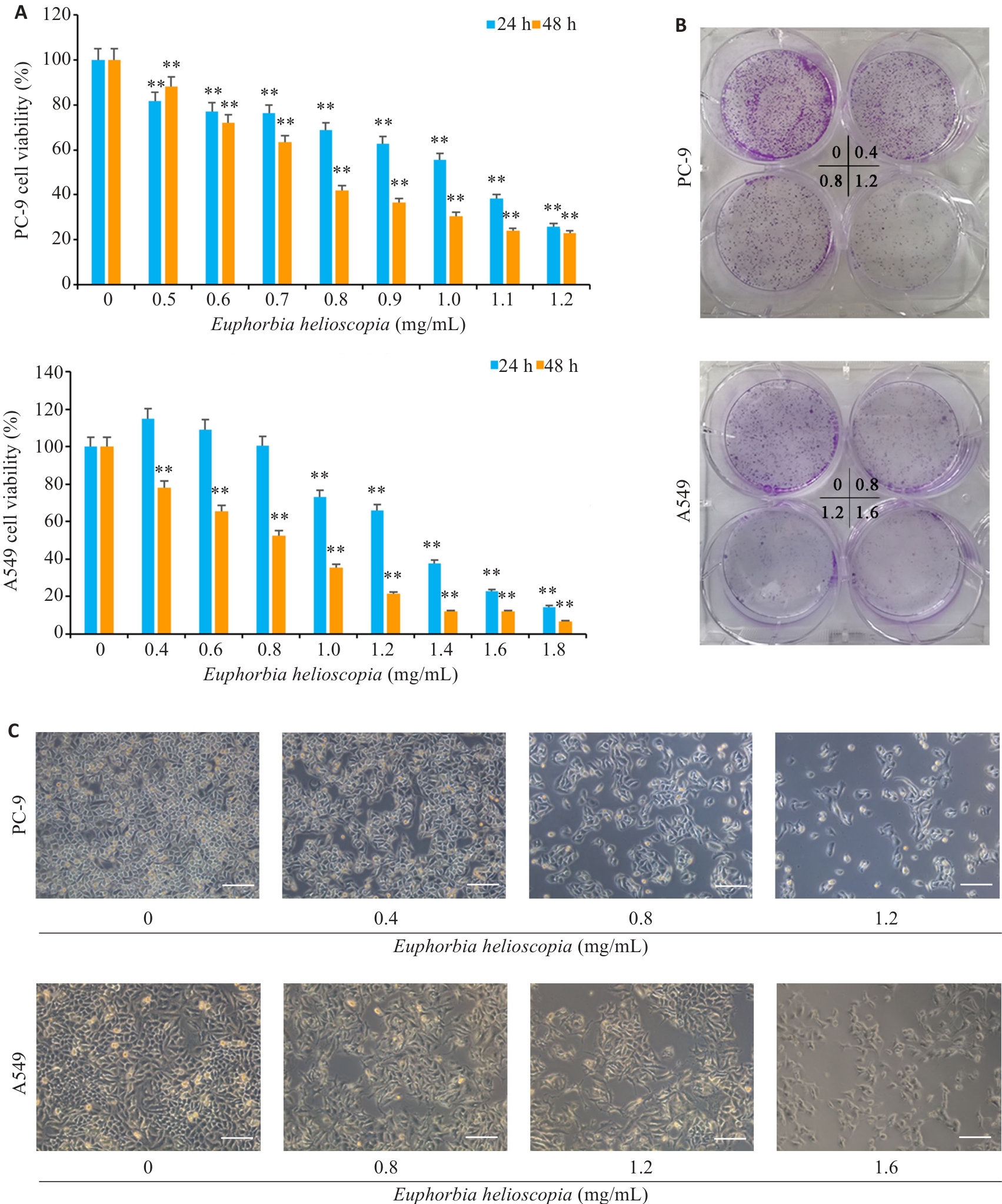
Fig.1 Euphorbia helioscopia inhibits proliferation of PC-9 and A549 cells. A: CCK-8 assay. B: Colony formation assay of PC-9 and A549 cells. C: Morphological changes of PC-9 and A549 cells (scale bar=200 μm). **P<0.01 vs 0 mg/mL.
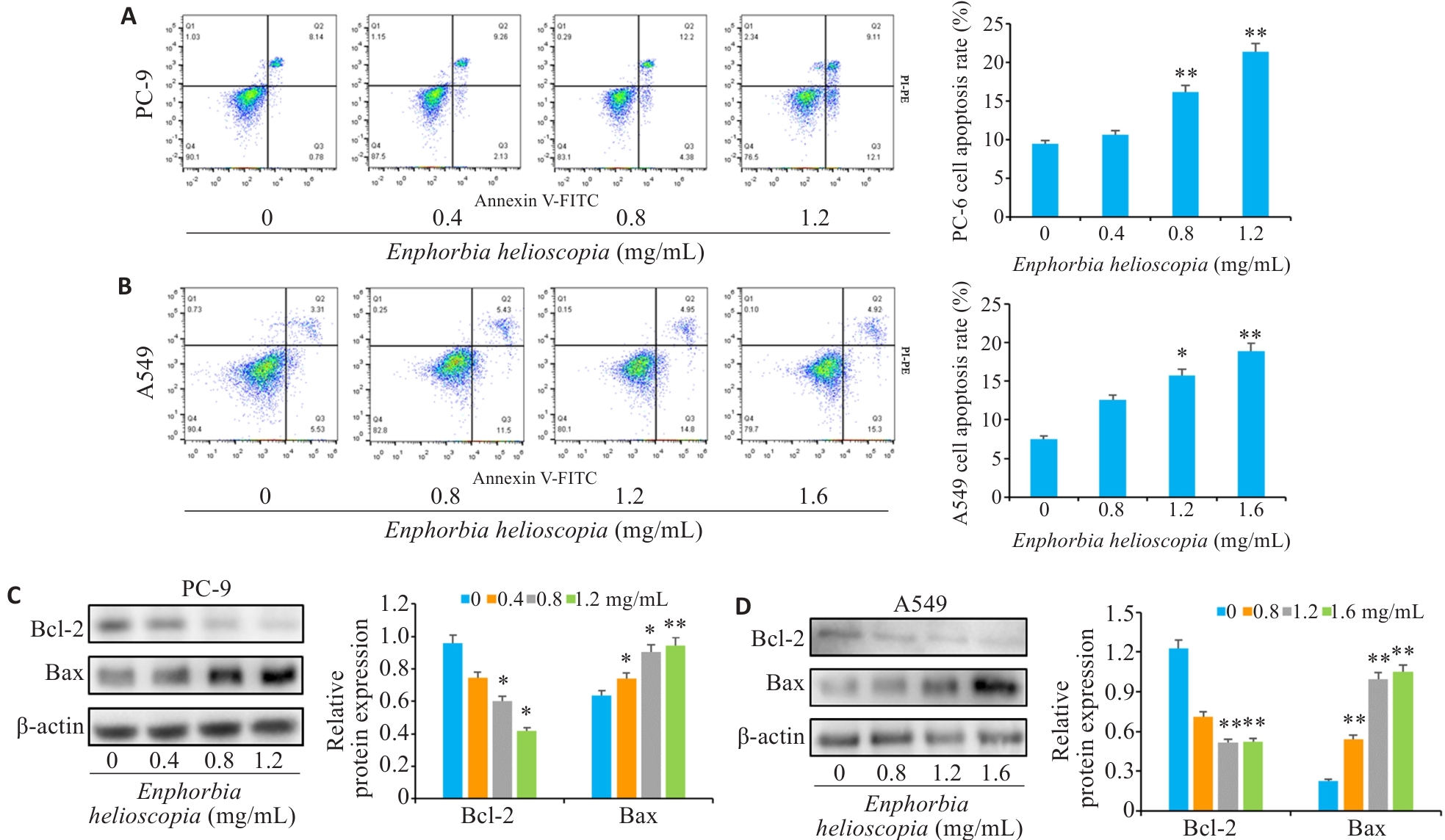
Fig.2 Euphorbia helioscopia induces apoptosis in PC-9 and A549 cells. A: Apoptosis of PC-9 cells treated with different concentrations of Euphorbia helioscopia (0, 0.4, 0.8, and 1.2 mg/mL) detected by flow cytometry. B: Apoptosis of A549 cells treated with different concentrations of Euphorbia helioscopia (0, 0.8, 1.2, 1.6 mg/mL) detected by flow cytometry. C: Expressions of Bcl-2 and Bax in PC-9 cells detected by Western blotting. D: Expressions of Bcl-2 and Bax in A549 cells detected by Western blotting. *P<0.05, **P<0.01 vs 0 mg/mL.
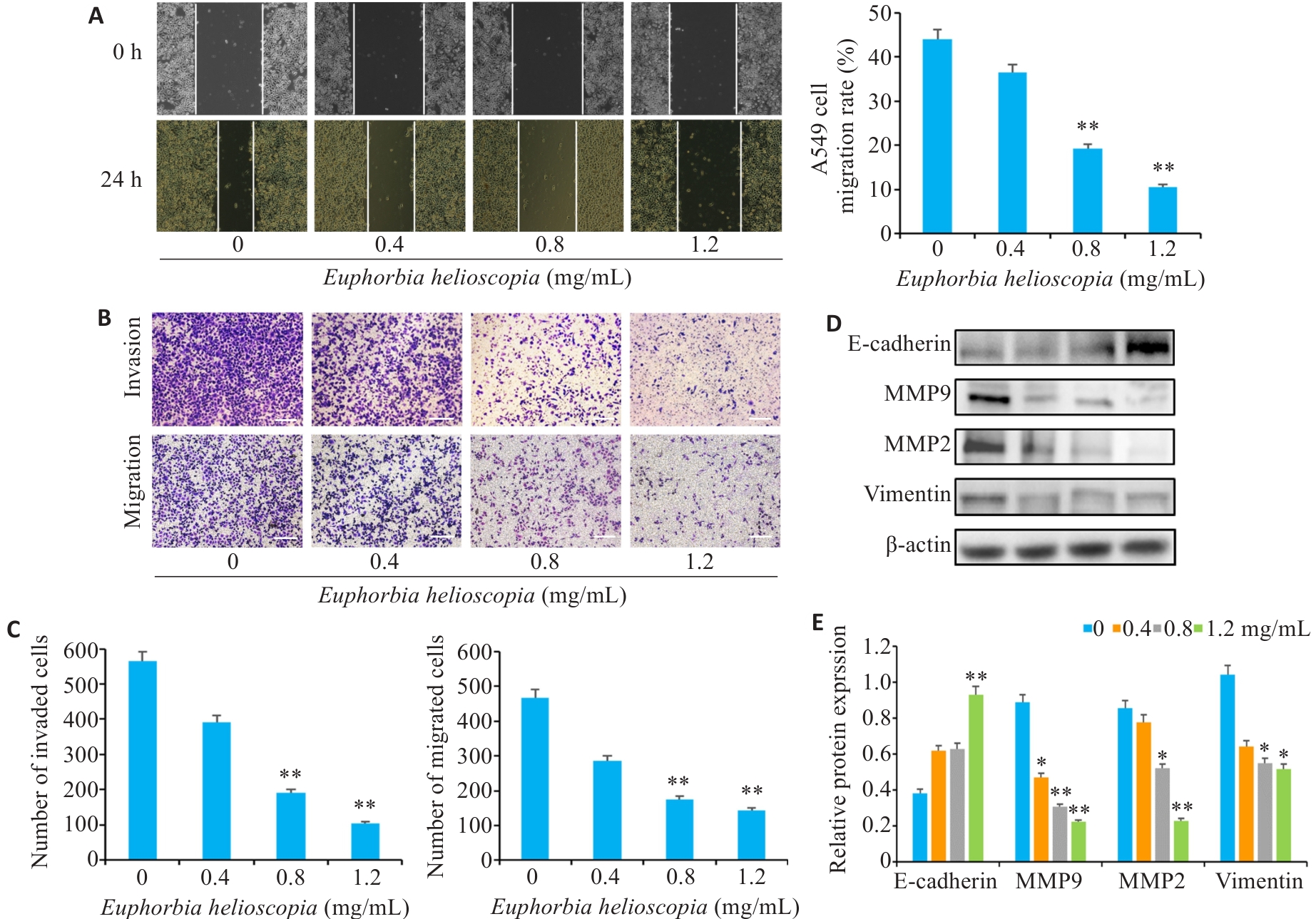
Fig.3 Euphorbia helioscopia inhibits invasion and migration of PC-9 cells. A: Wound healing assay of PC-9 cells treated with different concentrations of Euphorbia helioscopia. B: Crystal violet staining of the cells (scale bar=200 μm). C: Numbers of PC-9 cells passing through Transwell chamber. D, E: Expressions of E-cadherin, vimentin, MMP2, and MMP9 in PC-9 cells detected by Western blotting. *P<0.05, **P<0.01 vs 0 mg/mL.
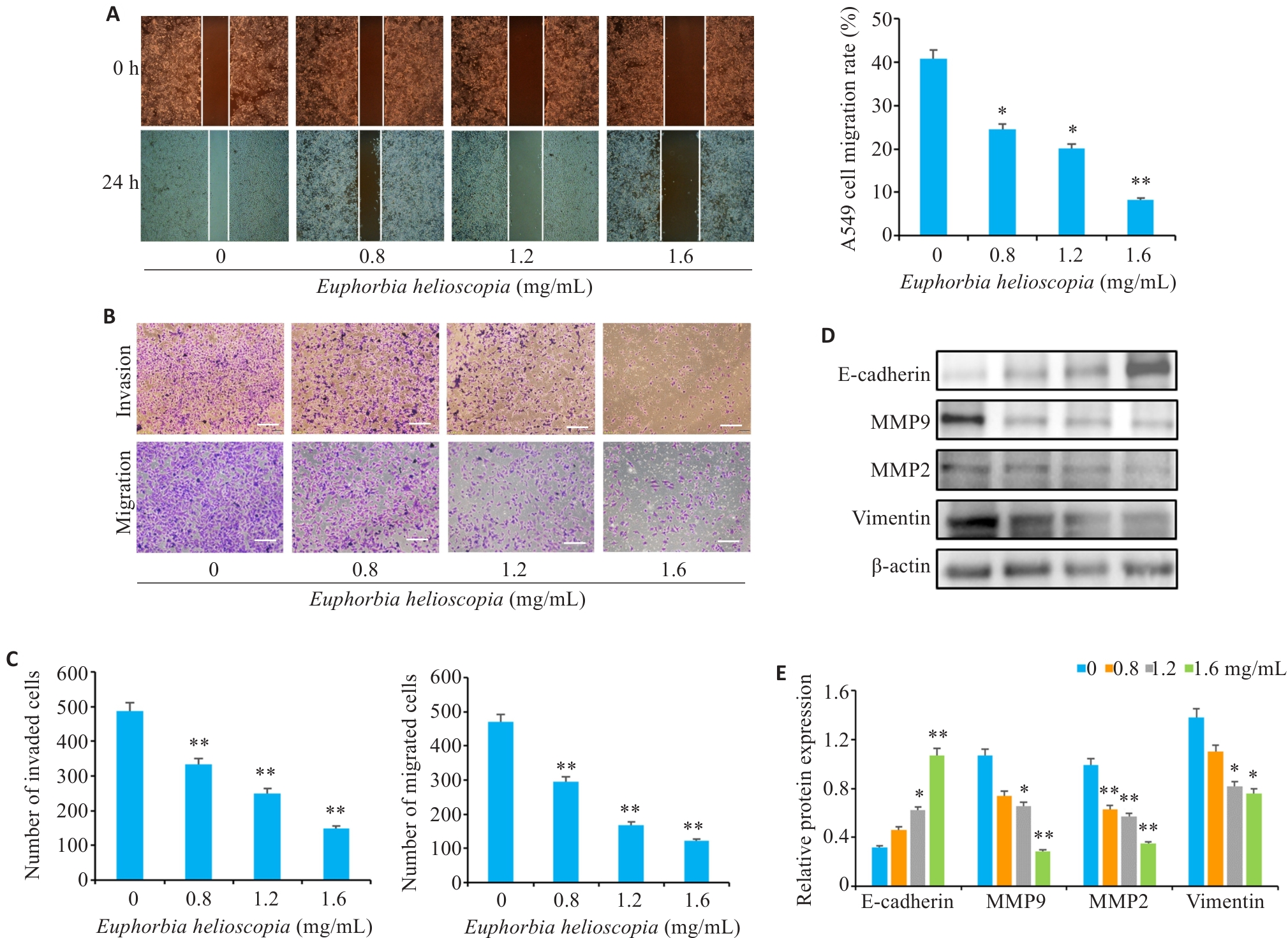
Fig.4 Euphorbia helioscopia inhibits invasion and migration of A549 cells. A: Wound healing assay of A549 cells treated with different concentrations of Euphorbia helioscopia. B: Crystal violet staining of the cells (scale bar=200 μm). C: Numbers of A549 cells passing through Transwell chamber. D, E: Expressions of E-cadherin, vimentin, MMP2, and MMP9 in A549 cells detected by Western blotting. *P<0.05, **P<0.01 vs 0 mg/mL.
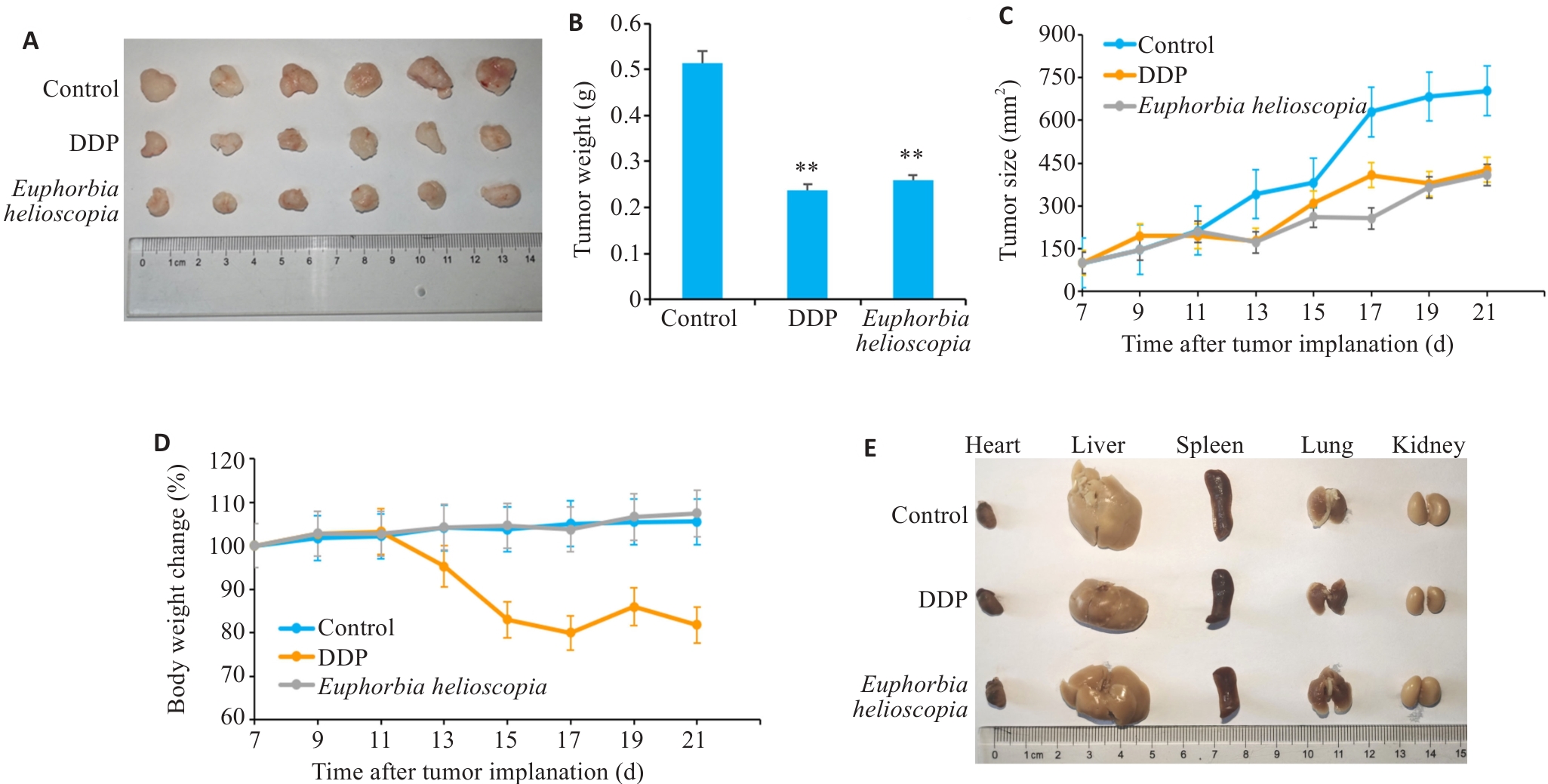
Fig.5 Euphorbia helioscopia inhibits growth of PC-9 cell xenografts in nude mice. A: Tumor growth in each group. B: Tumor weight in the 3 groups. C: Tumor size in the 3 groups. D: Body weight changes of the mice. E: Heart, liver, spleen, lung, and kidney tissues of the mice in the 3 groups. **P<0.01 vs control.
| 1 | Bray F, Laversanne M, Sung H, et al. Global cancer statistics 2022: GLOBOCAN estimates of incidence and mortality worldwide for 36 cancers in 185 countries[J]. CA Cancer J Clin, 2024, 74(3): 229-63. |
| 2 | Zheng RS, Chen R, Han BF, et al. Cancer incidence and mortality in China, 2022[J]. Zhonghua Zhong Liu Za Zhi, 2024, 46(3): 221-31. |
| 3 | SIEGEL R L, MILLER K D, WAGLE N S, et al. Cancer statistics, 2023 [J]. CA: a cancer journal for clinicians, 2023, 73(1): 17-48. |
| 4 | Alduais Y, Zhang HJ, Fan F, et al. Non-small cell lung cancer (NSCLC): a review of risk factors, diagnosis, and treatment[J]. Medicine, 2023, 102(8): e32899. |
| 5 | Buriolla S, Pelizzari G, Corvaja C, et al. Immunotherapy in NSCLC patients with brain metastases[J]. Int J Mol Sci, 2022, 23(13): 7068. |
| 6 | Vogelbaum MA, Brown PD, Messersmith H, et al. Treatment for brain metastases: ASCO-SNO-ASTRO guideline[J]. J Clin Oncol, 2022, 40(5): 492-516. |
| 7 | Reck M, Ciuleanu TE, Lee JS, et al. Systemic and intracranial outcomes with first-line nivolumab plus ipilimumab in patients with metastatic NSCLC and baseline brain metastases from CheckMate 227 part 1[J]. J Thorac Oncol, 2023, 18(8): 1055-69. |
| 8 | Mavrikios A, Remon J, Quevrin C, et al. Local control strategies for management of NSCLC with oligoprogressive disease[J]. Cancer Treat Rev, 2023, 120: 102621. |
| 9 | 王 芳, 杨兴嫕, 孙 琮, 等. 气血瘀滞型非小细胞肺癌患者 “瘀毒” 病机临床特征及补肺化瘀汤辅助治疗干预机制[J]. 广州中医药大学学报, 2024, 41(1): 68-77. |
| 10 | 刘志斌, 张 磊. 张维骏教授基于 “痰瘀互结” 理论治疗非小细胞肺癌临床经验[J]. 广西中医药, 2022, 45(5): 47-9. |
| 11 | 陈颖娟, 陈 晓, 李海峰, 等. 泽漆汤症证病机方药探析[J]. 上海中医药杂志, 2023, 57(1): 66-70. |
| 12 | 周 兰, 高红芳. 从正虚络阻探讨泽漆汤辨治肺癌[J]. 河南中医, 2023, 43(4): 492-5. |
| 13 | 王 冬, 张翔宇, 邵莹莹, 等. 中药泽漆及其复方制剂抗肿瘤药理作用与临床应用研究进展[J]. 天津中医药, 2023, 40(3): 402-8. |
| 14 | 霍 雁, 李淑芳. 黄吉赓辨治痰饮咳喘经验[J]. 中医文献杂志, 2021, 39(5): 69-71. |
| 15 | 王 嘉. 泽漆汤治疗肺癌恶性胸腔积液及对T淋巴细胞亚群影响的临床观察[D]. 济南: 山东中医药大学, 2021. |
| 16 | 高春迪. 基于PI3K/AKT信号通路探讨泽漆汤对肺腺癌的干预机制[D]. 济南: 山东中医药大学, 2022. |
| 17 | 王 今, 沈 佳. 沈佳运用《金匮要略》泽漆汤加减治疗肺结节经验[J]. 中医药导报, 2021, 27(10): 187-90. |
| 18 | Li XQ, Bai YL, Zhang DL, et al. Euphornin reduces proliferation of human cervical adenocarcinoma HeLa cells through induction of apoptosis and G2/M cell cycle arrest[J]. Onco Targets Ther, 2018, 11: 4395-405. |
| 19 | Mu HY, Gong CY, Zhang RJ, et al. Diterpenoids from Euphorbia helioscopia and their enhancement of NK cell-mediated killing of NSCLC cells[J]. Bioorg Chem, 2022, 119: 105534. |
| 20 | 阳 柳, 范先基, 宁雪坚, 等. 葶苈泽漆汤对肺癌恶性胸腔积液患者生存期及Th1、Th2细胞因子失衡的影响[J]. 解放军预防医学杂志, 2019, 37(7): 150-1. |
| 21 | 孙 宇, 刘 琳, 王英力. 泽漆扶正散结汤联合化疗治疗乳腺癌疗效观察[J]. 现代中西医结合杂志, 2022, 31(6): 775-9. |
| 22 | Cheng JS, Han W, Wang ZY, et al. Hepatocellular carcinoma growth is inhibited by Euphorbia helioscopia L. extract in nude mice xenografts[J]. Biomed Res Int, 2015: 601015. |
| 23 | 邵 远, 柳鹏程, 程军胜, 等. 泽漆乙酸乙酯提取物对SGC7901/DDP多药耐药性的逆转及机制[J]. 中成药, 2017, 39(8): 1713-7. |
| 24 | Yan ZK, Lai ZJ, Lin JM. Anticancer properties of traditional Chinese medicine[J]. Comb Chem High Throughput Screen, 2017, 20(5): 423-9. |
| 25 | 曹 策, 李玲美, 訾明杰, 等. 医学研究中动物实验样本量的确定方法[J]. 中国比较医学杂志, 2023, 33(2): 99-105. |
| 26 | 李 雪, 姜懿洋, 李彬彬, 等. 泽漆汤治疗肺癌的研究进展 [J/OL]. 中华中医药学刊,2024, |
| 27 | Cui JH, Zhang C, Lee JE, et al. MLL3 loss drives metastasis by promoting a hybrid epithelial-mesenchymal transition state[J]. Nat Cell Biol, 2023, 25(1): 145-58. |
| 28 | Sahu SK, Agirre E, Inayatullah M, et al. A complex epigenome-splicing crosstalk governs epithelial-to-mesenchymal transition in metastasis and brain development[J]. Nat Cell Biol, 2022, 24(8): 1265-77. |
| 29 | 胥孜杭, 朱杨壮壮, 张 飞, 等. 泽漆汤对肺癌原位模型小鼠的抑制作用[J]. 中国实验方剂学杂志, 2019, 25(14): 6-12. |
| 30 | 张永为, 夏华峰, 范丽萍, 等. 泽漆汤对小鼠Lewis肺癌抑制作用及survivin蛋白表达的影响[J]. 中华中医药学刊, 2012, 30(11): 2489-91, 后插8. |
| 31 | 杨唯曦. 泽漆扶正散结汤联合化疗方案治疗乳腺癌患者的临床效果[J]. 中国实用医药, 2023, 18(15): 141-3. |
| 32 | 唐 琳, 顾佳麟, 杨汪银, 等. 经方治疗肿瘤相关咳嗽的应用及研究进展[J]. 中医药临床杂志, 2020, 32(7): 1399-401. |
| Viewed | ||||||
|
Full text |
|
|||||
|
Abstract |
|
|||||